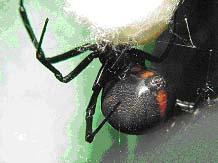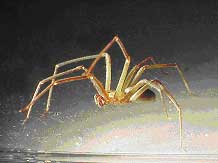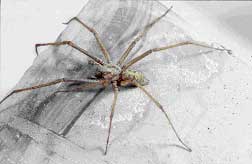Spiders
INTRODUCTION. There are over 38,000 species of spiders worldwide, with about 3,500 occurring in North America. Many species of spiders are household pests. Wherever their food is available; spiders are likely to be found. All spiders are predators, feeding mainly on insects and other small arthropods.
In the United States, three spider groups are considered medically important: the black widow, brown recluse, and Hobo spiders. RECOGNITION. Non-insect arthropods with 2 body regions, cephalothorax (head and thorax) and abdomen connected by a tiny waist (pedicel). Antennae absent. Usually 8 simple eyes, occasionally 6. Below eyes are 2 chelicerae or jaws which end in a hollow fang, connected internally to poison glands. With 1 pedipalp (palp) between chelicerae and 1st pair of legs on each side. Legs slender, 4 pairs. Abdomen unsegmented, with a group of fingerlike spinnerets (produce silk) on posterior or rear end. Males usually smaller than females and with terminal pedipalp segment greatly swollen, may also differ in coloration. The immature stages are egg and spiderlings, the latter closely resemble the adults except for size and sometimes coloration. IDENTIFICATION. Since black widow, brown recluse, and Hobo spiders are of primary importance in human environments, their identification is essential. Several different species may be involved and which can only be identified by experts. However, group recognition alone is sufficient for the purposes here. Black Widow. Adult female body length about ½" including an almost spherical abdomen about ¼-3/8" in diameter, with overall length including legs of about 1 ½ - 1 3/3"; males about half female size. Color typically black, abdomen on underside with 2 reddish triangular markings usually joined to form a reddish hourglass-shaped marking but sometimes separated (“split hourglass”) or only a single mark; usually with red markings above spinnerets. Brown Recluse. Adults usually about ¼ - ½" in body length. Color tan to dark brown with a darker fiddle-shaped marking on top of cephalothroax whose neck points towards abdomen. Uniquely, with 6 eyes arranged in 3 groups of 2 (diads) in a semicircle. Found primarily in southern states. Hobo Spider. Adult female body length about 7/16 - 5/8" including oblong abdomen, male body length about slightly smaller. Total size including legs about 1-1 ¾" in diameter. Color variable with carapace (top of cephalothorax) light to medium brown, with dark stripe to either side of lighter midline stripe, dark stripe with lateral extensions in posterior half; abdomen with interrupted light midline stripe with about 5 light colored triangular shaped loops on each side bordered by a dark background. Last 2 or 3 loops chevron-shaped. Found only in the northwest United States. BIOLOGY. After mating, females produce egg sacs. Depending on the species, one or more sacs may be made. Early instars (spiderlings) spin a silk thread into the air and float out on the breeze like kites. This is called ballooning and provides for general dispersal of the species. Spiderlings go through 4 - 12 molts before maturity. Most spiders live for 1 to 2 years. Spiders are predators, paralyzing or killing their pry with venom. They typically feed by injecting a predigestive fluid into the body of their pry and then suck in the digested liquid food. Spiders can survive without food for several weeks to a few months. Most spiders are nocturnal and hunt or capture prey primarily at night. During the day, they hide and remain inactive in cracks and crevices. Spiders rarely bite people and only do so as a means of defense. CONTROL. Spider control is a multi-step process. 1. Inspection. A thorough inspection of the building is essential and many have to be made at night because most spiders are nocturnal. 2. Identification. Accurate identification is important for both pest management and medical reasons. 3. Prevention. This consists of making sure that the building is in good physical condition, and properly screened and sealed to reduce entry. Also, changing the lighting to off-building locations, from mercury vapor to sodium vapor lamps, or in the case of homes, changing the bulbs near the entrances to yellow bulbs, may be of help in reducing attractiveness to insects and hence spiders. 4. Sanitation. Such practices consist of keeping the premises free of debris such as boxes, papers, clothing, lumber piles, etc; it is wise to wear protective gloves and clothing when cleaning out such accumulations of clutter. A thorough housekeeping should be done twice each year. Outside, remove debris, firewood and lumber piles, landscape timbers, stones, etc. Keep the grass mowed to 3” or less and trim back any vegetation in contact with the structure. 5. Mechanical measures. The key to control is the timely mechanical removal of spiders and webs, but especially the egg sacs with a vacuum, both inside and outside; seal and dispose of the bad immediately. If a broom is used for the removal, then it is suggested that if a spider is present on the web that an appropriately labeled insecticide be used for a quick contact kill before removal of the web. 6. Pesticide application. If desired, chemical control consists of the application of appropriately labeled dusts, wettable powders, microencapsulated, or lacquer pesticides in typical spider harborages. Perimeter treatments are helpful. If web-building spiders are the problem, lightly dusting the web with a non-repellent dust is very effective. Control of spider insect food is desirable but will only help in long term as spiders can go for weeks or months without food.







